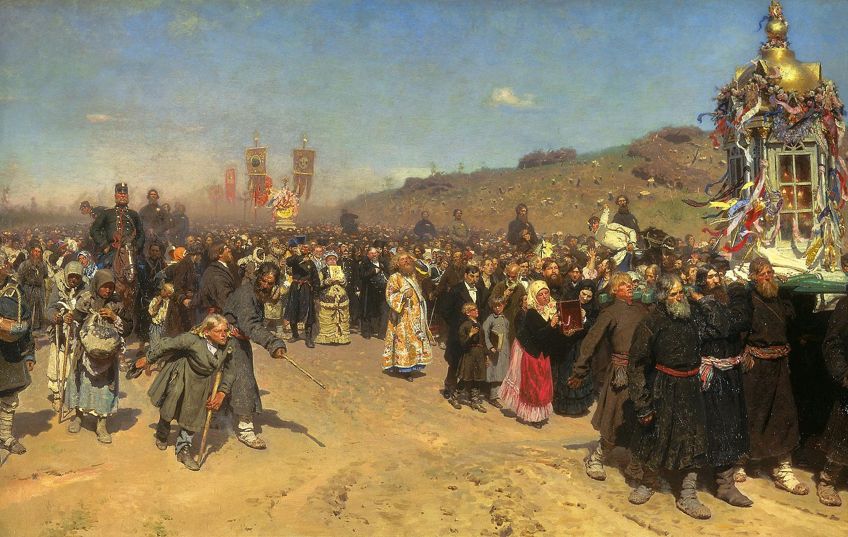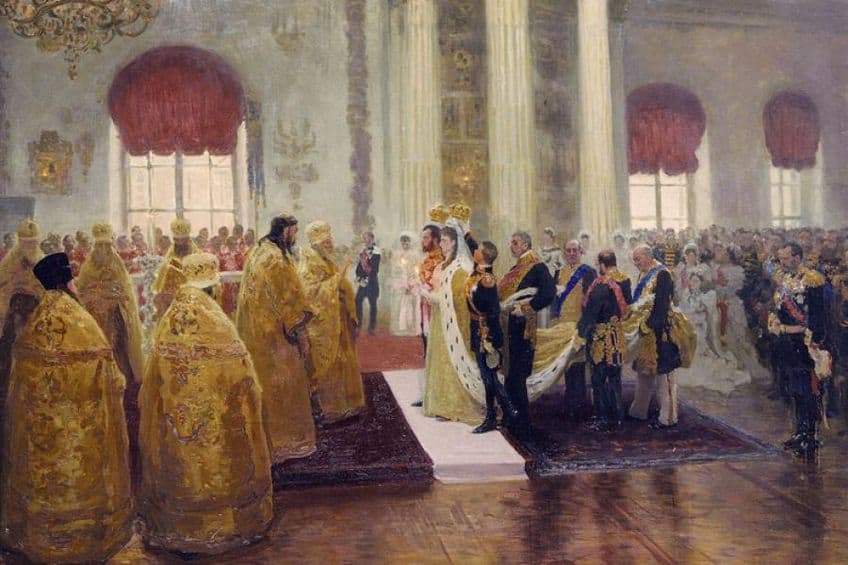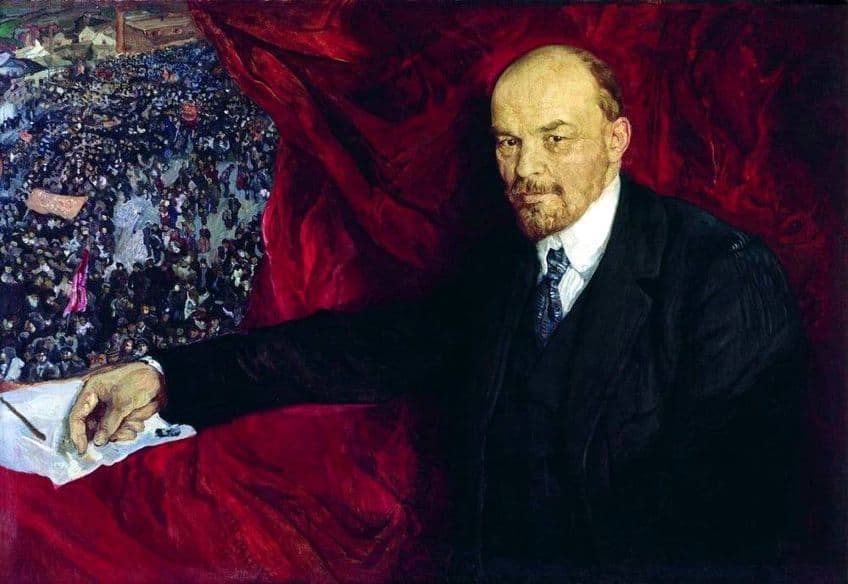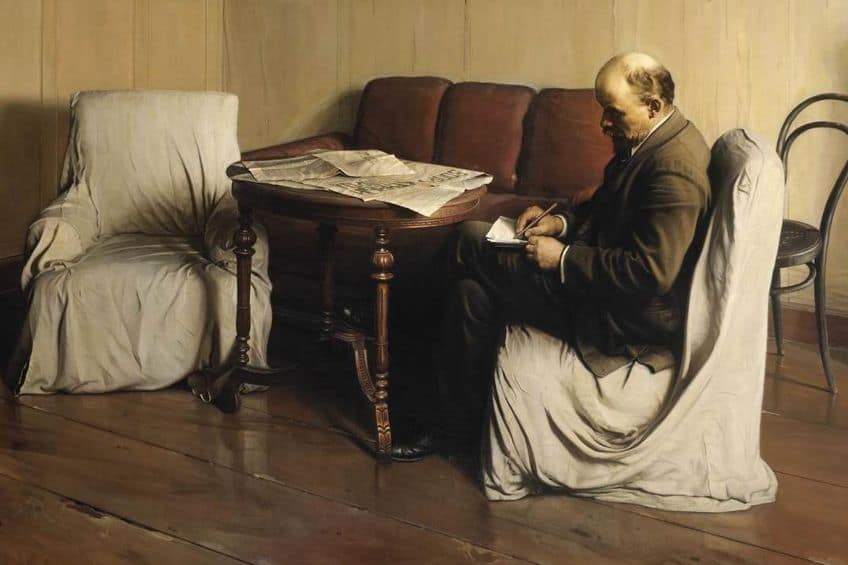Socialist Realism Art – The Significance of Soviet Realism
What is Socialist Realism art? It was a kind of Soviet artwork produced by communist artists following Stalin’s rise to power in 1924, although forms of Soviet Realism had been produced since the Communist Revolution in 1917. Despite the fact that these communist artworks are known as works of “Soviet Realism”, they were typically highly stylized. To learn more about these Stalin artworks and other types of Soviet artworks, let’s explore Socialist Realism art.
Contents
What Is Socialist Realism Art?
Socialist Realism art is defined by the portrayal of communist principles such as proletarian liberation. Soviet art was created with a very literal and clear message, primarily depicting an idealistic USSR. Typically, Soviet Realism lacked nuanced aesthetic interpretation or meaning. From its beginnings in the early 1920s to its ultimate decline from its officially recognized status in the late 1960s until the Soviet Union’s disintegration in 1991, communist artworks were the primary form of sanctioned art in the Soviet Union.

The Development of Socialist Realism Art
Throughout several decades, countless Communist artists from various regions of a very diverse society contributed to the development of Socialist Realism art. The work of Ilya Yefimovich Repin and Peredvizhnikis are early instances of Soviet Realism in Russian art. While these Soviet artworks do not have the same political implication as those that followed, they do demonstrate the approaches used by them. There was a significant shift in artistic forms when the Bolsheviks took power in Russia on the 25th of October, 1917. There had been a brief period of creative experimentation in the time between the downfall of the Tsar and the emergence of the Bolsheviks.
Anatoly Lunacharsky was elected chairman of the People’s Commissariat for Enlightenment, soon after the Bolsheviks got into power.

This put Lunacharsky in charge of determining the path of art in the newly formed Soviet state. While Lunacharsky did not impose a particular aesthetic standard for Soviet communist artists to follow, he devised a philosophy of aesthetics centered on the human body that would ultimately contribute to shaping Socialist Realism art. “The image of a healthy body, intellectual face, or welcoming expression was fundamentally life-enhancing”, Lunacharsky felt. He came to the conclusion that art had a direct influence on the human body, and that given the appropriate conditions, that effect may be beneficial. Lunacharsky claimed that by representing “the perfect human”, Soviet art could educate individuals on how to be ideal Soviet citizens.
Artistic Debates Within Soviet Art
The fate of Soviet art was debated by two major groups: the traditionalists and the futurists. Russian Futurists, a number of whom had been producing leftist or abstract art before the Bolsheviks, thought that communism demanded a clean break from the past, and hence, so did Soviet artwork. Traditionalists felt that authentic portrayals of ordinary life were important. There was some private commercial industry during Lenin’s leadership, allowing both traditionalists and Futurists to produce their work for wealthy people. The Soviet government had gained sufficient power and authority by 1928 to abolish private businesses, effectively eliminating financing for fringe movements such as the Futurists.
While the term “Socialist Realism” was not used at this time, its distinguishing traits became the standard.

On the 23rd of May, 1932, Ivan Gronsky, head of the organizational committee of the Union of Soviet Writers, used the phrase for the first time in the media in Literaturnaya Gazeta. The word was agreed upon at meetings attended by top-level politicians, including Joseph Stalin. Maxim Gorky, a supporter of literary Socialist Realism, wrote the renowned piece Socialist Realism in 1933. Four rules were established for Socialist Realism art at the Conference of 1934. The first rule was that the artwork had to be proletarian and had to be understood by (and relevant to) the workers. The second rule was that the artwork had to be typical of the scenes of life experienced by ordinary citizens. The third rule was that the works needed to be represented realistically. And the final rule was that all Soviet communist artwork needed to be supportive of the goals of the state.
Characteristics of Soviet Realism
The objective of Socialist Realism art was to confine popular culture to a restricted, tightly controlled subset of emotional expressions that reinforced Soviet ideology. The reverence of the state was the most important aspect and was always to be presented favorably. The goal of these communist artworks was to depict the idealized Soviet society, therefore there was a heightened sense of optimism. Not only was the present exalted, but the future was also expected to be depicted positively. Communist artwork had a feeling of forced optimism since the current moment and future were perpetually romanticized.
Tragic events and negativity were forbidden unless presented at a different period or place. This attitude inspired what would subsequently be labeled “Revolutionary Romanticism”.
The average worker, whether industrial or agricultural, was glorified by Revolutionary Romanticism by having his life, labor, and amusement depicted as admirable. Its goal was to demonstrate how much the standard of life had advanced as a result of the revolution. The overall objective was to produce “a completely new kind of human”, as Lenin put it. Communist artwork was a means of instilling party values on a large scale. Stalin regarded the communist artists as “engineers of souls”. The body, sunlight, flowers, flight, youth, industry, and new technology were all prominent images in Socialist Realism art. These poetic motifs were employed to depict the Soviet state’s utopianism. Art became more than just a form of entertainment; it now had a particular purpose. Since Soviet ideologies valued efficiency and productivity over everything else, art must have a function to be admired. The themes represented would include the beauty of labor and communal and individual accomplishments for the benefit of the community. The artwork would typically incorporate an easily recognizable educational message.

The communist artists, on the other hand, were not allowed to depict reality exactly as they experienced it since anything that reflected negatively on Communism had to be suppressed. Individuals who could not be established to be unambiguously good or bad could not be utilized. Paintings represented bustling agricultural and industrial settings, while sculptures portrayed laborers, sentries, and children. Creativity was not valued in Socialist Realism. Throughout this time period, the styles chosen to create art were ones that would offer the most realistic images. Artists would represent smiling, strong peasants and factory workers.
Throughout the Stalin era, they produced a multitude of heroic Stalin artworks to support his personality cult – all in the most realistic way possible.
Significant Socialist Realism Art Groups
Socialist Realism is defined as a Marxist aesthetic philosophy that promotes the didactic utilization of art, literature, and music to create social awareness in a growing society. Starting during the 1917 Communist Revolution and intensifying during Stalin’s reign until the early 1980s, Soviet Realism pressured artists of all types to produce positive or inspiring reflections of a utopian communist lifestyle by employing any visual media, such as movies, posters, newspapers, radio, and theater. Vladimir Lenin, the Russian government’s leader from 1917 to 1924, provided the groundwork for this emerging era of art, arguing that art is for the masses and that the public should understand and appreciate it in order to unite them.
Antoine Pevsner and Naum Gabo, communist artists under Lenin, sought to establish the borders of art by drafting The Realist Manifesto in 1920, arguing that artists should be allowed free reign to create whatever their imagination dictated.

Lenin, on the other hand, saw art as utilitarian, and Stalin expanded on the view that art should be propaganda. Individual artists and their art were therefore repurposed as state-controlled propaganda. After Stalin’s death in 1953, he was replaced by Nikita Khrushchev, who pushed for less severe state regulations and outright opposed Stalin’s aesthetic demands in 1956, initiating a policy reversal. He felt that individuals should not be restricted and ought to be able to support themselves solely through their artistic abilities. In 1964, Khrushchev was deposed and succeeded by Leonid Brezhnev, who reinstated Stalin’s ideals and overturned Khrushchev’s aesthetic decisions. The Socialist Realist movement, nevertheless, had started declining by the early 1980s.
Association of Artists of Revolutionary Russia
The AKHRR was founded in 1922 and was one of the most significant artist organizations in the USSR. It used “heroic realism” to properly reflect modern living in Russia. The phrase “heroic realism” was the start of the archetype of Socialist Realism. It was endorsed by powerful government figures like Leon Trotsky and was popular among the Red Army. It was renamed the Association of Artists of the Revolution in 1928 to include the remaining Soviet nations.
At this stage, the group began to participate in state-sponsored mass art forms such as murals, collaborative paintings, advertisement creation, and textile design. The group disbanded on the 23rd of April, 1932.
The Impact of Socialist Realism Art
The influence of Socialist Realism art would continue to be apparent decades after it was no longer the principal style promoted by the state. Even prior to the demise of the USSR in 1991, the government had been decreasing its censorship practices. In 1953, upon Stalin’s death, Nikita Khrushchev started criticizing the previous regime’s severe constraints. This autonomy encouraged artists to try out novel approaches, although the change was gradual. Artists were no longer constrained by the ousted Communist Party until the eventual demise of Soviet power. Until the mid-to-late 1990s and early 2000s, several Socialist Realism ideologies were still prevalent.

Several Russian artists employed Socialist Realism art’s qualities ironically throughout the 1990s. This was nothing like what had existed only a few decades earlier. There was a dramatic power shift after artists broke out from the Socialist Realism mold. Artists started to incorporate topics that would not have been allowed under Communist rule. With the government’s control on aesthetics eliminated, artists gained a level of influence not seen since the early 20th century. In the decade following the demise of the Soviet Union, artists portrayed the Soviet legacy and its associated artworks as a tragic event.
There was a distinct sense of detachment throughout the following decade. Western societies do not always regard Socialist Realism favorably.
Democratic countries regard the art created during the repressive period as a deception. Non-Marxist art historians often see communist art as a sort of authoritarianism that suffocates artistic creativity and hence slows cultural advancement. The installation of the Institute of Russian Realist Art, a museum dedicated to conserving 20th-century Socialist Soviet artworks, has resulted in a revival of the style in Moscow in recent years.
Notable Socialist Realism Artworks
Like every other movement throughout art history, Socialist Realism art backed artists of technical competence and vision – in fact, it is worth noting that art, in general, has only recently attained a position of freedom from political indoctrination, and only in some regions of the world. Isaak Brodsky is one of several extraordinarily gifted artists who worked in a manner that imposed thematic and stylistic constraints. During the 1940s and 1950s, a new generation of painters, the majority of whom were born under Soviet control, had created a more conservative collection of work. Others, on the other hand, kept advancing with whatever tools were available to them, using lighting effects, for instance, or the Impressionist technique, to imprint their work with originality.

Lenin in Smolny (1930) by Isaak Brodsky
| Artist | Isaak Brodsky (1884 – 1939) |
| Date Completed | 1930 |
| Medium | Oil on canvas |
| Dimensions (cm) | 287 x 190 |
| Location | The State Tretyakov Gallery, Moscow, Russia |
One of the most renowned pieces of Socialist Realist art is Brodsky’s painting of Lenin, which portrays Lenin at the Smolny Institute, the seat of the government in the months after the October Revolution. From the dust sheets draped over the seats in the improvised office to Lenin’s simple outfit and look of quiet concentration, every aspect of the image is meant to juxtapose with the lavish splendor of Tsarist Russia. At over three meters tall, the canvas depicts the commander as nearly life-size, emphasizing the artwork’s lifelike realism.
Brodsky’s technical skill is evident in the representation of the polished wood of the furniture, the textures of the textiles, and the shimmering floor – the piece is almost photographic in its realism.

It was one of several works created by Brodsky following Lenin’s death in 1924 to deify the ruler. It, like many Socialist Realism artworks, gazes back to a golden era in Soviet history, in this instance the first few months of the revolutionary government, instead of grappling with the difficulties of modern life. Yet, it captures the passion and enthusiasm of the early days, as well as the trust placed in Lenin’s authority, while also foreshadowing the version of Brodsky’s Realist style that would be enforced from above after 1932.
New Moscow (1937) by Yuri Pimenov
| Artist | Yuri Pimenov (1903 – 1977) |
| Date Completed | 1937 |
| Medium | Oil on canvas |
| Dimensions (cm) | 171 x 147 |
| Location | The State Tretyakov Gallery, Moscow, Russia |
The observer is seated in the rear of an open-top automobile traveling through central Moscow, with a female driving, in Yuri Pimenov’s 193 painting. There is progression all around: automobiles are everywhere, a tram goes towards new skyscrapers, and an entry to the much-touted Moscow metro is seen to the side. Busy workers rush about their days, scattered throughout the landscape like specks of color. Levels of symbolic imagery may be uncovered beneath the painting’s commonplace surface; the red flower placed on the car’s windscreen, for instance, signifies the communist artist’s admiration for the Soviet Union.
Despite the severe implementation of Socialist Realist ideas by this stage in Stalin’s administration, Pimenov’s artwork demonstrates the restricted but inevitable degree to which Russian artists continued to experiment with style.
The artwork is essentially Impressionist in style as if striving to recreate the impression of rain-soaked streets; nonetheless, the hazy texture creates a feeling of dreamy aspirations. Pimenov’s reality was considerably different from the one he was forced to portray, and open-top motor vehicles were a luxury inconceivable to the overwhelming percentage of the country’s people.
Stalin and Voroshilov in the Kremlin (1938) by Aleksandr Gerasimov
| Artist | Aleksandr Gerasimov (1881 – 1963) |
| Date Completed | 1938 |
| Medium | Oil on canvas |
| Dimensions (cm) | 140 x 181 |
| Location | The State Tretyakov Gallery, Moscow, Russia |
Gerasimov’s enormous portrait of Joseph Stalin and his close comrade Kliment Voroshilov, a significant member of Stalin’s administration, and a regular subject of Gerasimov’s artworks, stands about three meters tall. Nikita Khrushchev subsequently said that Voroshilov spent more time at Gerasimov’s studio than in administration. In this artwork, he, like Stalin, appears to be a model of focused attention. As they stroll beside a Kremlin tower, the duo mirror each other’s stances in a gesture of solidarity. The men appear to be immersed in dialogue, their forward eyes indicating an emphasis on the promising future of the Soviet Union. The proletariat queue up outside a factory in the backdrop, barely visible.
This artwork is loaded with symbolism. The concept of optimism is emphasized by a sky turning blue in the distance, as the clouds disperse after a rainfall, unveiling a fresh day.

The dark hues of the men’s outfits reflect those of post-revolution Moscow’s fences and buildings, while isolated bursts of red on Voroshilov’s military uniform echo the brilliance of the Soviet Star above the Kremlin and the Communist flags fluttering in the distance. We can clearly see the cult of personality forming in such pieces, which is a keystone of the Socialist Realist art style. In this Stalin artwork, he is portrayed as a fearless, daring, and inspiring leader, the loving father of millions of Soviet children.
Bread (1949) by Tatiana Yablonskaya
| Artist | Tatiana Yablonskaya (1971 – 2005) |
| Date Completed | 1949 |
| Medium | Oil on canvas |
| Dimensions (cm) | Unspecified |
| Location | The State Tretyakov Gallery, Moscow, Russia |
This image portrays a vibrant scene on a Kolkhoz, or community farm. A number of women smile and speak as they process the harvest, carrying shovels, filling bags, and transporting grain; a center figure pulls up her sleeves, towering proudly and smiling. A vast mound of grain ready to be delivered occupies the scene, adding to a warm color palette that suggests hope, dynamism, and vigor. Tatiana Yablonskaya, a Ukrainian artist, was only a baby when the Bolshevik Revolution changed her homeland. As a result, unlike other Socialist Realist painters, she had never experienced life outside of the Communist dictatorship.
Yet, her art frequently expresses a cultural and aesthetic devotion to her native area, which has long been renowned as “Russia’s breadbasket” due to its rich soil and mild climate.
Although this artwork is a piece of Realism, like many works which carry that label it was in fact the outcome of hundreds of drawings and studies. The artist stated that she aimed to create an epic image full of movement and sunshine “I tried my hardest to represent how I felt while I was at the communal farm. I strove to convey the cheerful community labor of our lovely people, the richness and strength of our community farms, and the victory of Lenin’s and Stalin’s principles in the socialist restoration of the village”.
That completes our look at Socialist Realism art. To recap, Socialist realism is an aesthetic style that emerged in the early 20th century in the Soviet Union and other communist nations. It was established as a type of propaganda to advocate socialism and communism’s ideals. Socialist realism art stresses realistic images of peasants, workers, and other members of the working class engaged in pursuits that support the socialist state’s values.
Frequently Asked Questions
What Is Socialist Realism Art?
Socialist Realism was frequently employed in the Soviet Union and other socialist nations to promote state objectives. It appeared in a wide range of media, encompassing sculpture, painting, literature, film, and architecture. While popular at the time, Socialist Realism is now mainly regarded as a remnant of the past and is seldom seen in modern art.
What Are the Characteristics of Soviet Artworks?
The simplicity, clarity, and absence of decoration characterize the style. It typically employs vivid, brilliant colors and simplistic, stylized shapes. The art is meant to be simple, understandable, and approachable to the general population, as well as to promote the socialist state’s principles.
Liam Davis is an experienced art historian with demonstrated experience in the industry. After graduating from the Academy of Art History with a bachelor’s degree, Liam worked for many years as a copywriter for various art magazines and online art galleries. He also worked as an art curator for an art gallery in Illinois before working now as editor-in-chief for artfilemagazine.com. Liam’s passion is, aside from sculptures from the Roman and Greek periods, cave paintings, and neolithic art.
Learn more about Liam Davis and about us.
Cite this Article
Liam, Davis, “Socialist Realism Art – The Significance of Soviet Realism.” artfilemagazine – Your Online Art Source. May 22, 2023. URL: https://artfilemagazine.com/socialist-realism-art/
Davis, L. (2023, 22 May). Socialist Realism Art – The Significance of Soviet Realism. artfilemagazine – Your Online Art Source. https://artfilemagazine.com/socialist-realism-art/
Davis, Liam. “Socialist Realism Art – The Significance of Soviet Realism.” artfilemagazine – Your Online Art Source, May 22, 2023. https://artfilemagazine.com/socialist-realism-art/.


